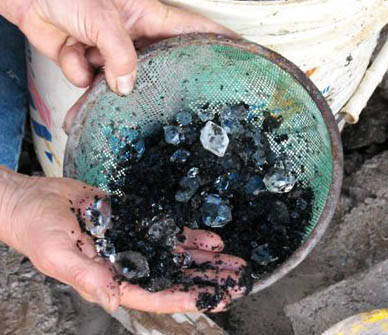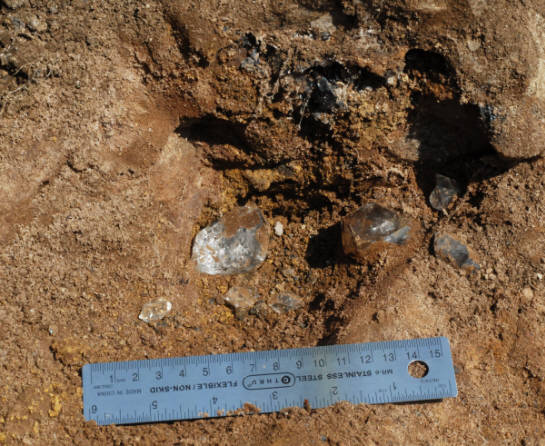Quartz Crystal Habits within Herkimer Diamond Deposits
The best website on "Herkimer Diamonds"
Larger photos of the thumbnails presented on the main "Crystal Form" page. Included is identification information and the source link is embedded there (just click). In some cases additional information and comments are provided for each photo.
Photos, and videos, of "in place" Herkimer bearing pockets


This link above is excellent in showing the opening of one type of Herkimer diamond pocket at one location - note pockets behave a little bit differentely at each loaction. This is a large a mud filled pocket, partially collapsed, and well shown in a series of photos. In addition the author has provided informative comments. Mud or clay minerals (found in mud) are associated with carbon material (in varying degrees) and Herkimer diamond pockets. The amount of clay, versus hydrocarbon or almost nothing, in a pocket is variable from one location to another even within the same quarry/mine. Much of the clay came into the pockets along with the hydrocarbon and can be found interlayered with it (see ).
There is also frequently a top to bottom zoning in larger pockets containing heavy clay, or heavy hydrocarbon material, with the larger amount of quartz crystals found on the bottom. This zoning is found across deposits in the Herkimer district and is particularly noticable the Hanson/Benchmark quarry, where the walls of the pocket are fresh and intact. This top to bottom zonation is probably more common than collectors realize, with many pockets (even small ones) having most of the larger Herkimers on the floor - even when not collapsed. It is true that since the last glacier ground water has moved through the rocks and caused changes to the rock, and to the pockets, but that is only part of the story. Some mud most likely moved around during that time, and frost/freezing had its effects, but clay mineral deposition is an important part of the history of Herkimer diamonds. Most skeletal crystals contain clay layers inside the crystal (see ) and all the deposits in the region contain some clay in association with the the hydrocarbon material. It is another piece of the tale Herkimer diamonds have to tell us.


See also the discusion on pocket mud and wall rock.

To the left is pocket photo from the TCR location, photographed August 2010 (Dr.D.). In this shot you can see hydrocarbon (arrow)and some yellow clay at the left end of the ruler and to the right of the hydrocarbon. This pocket is very close to the surface, note the roots (upper left) and that there is alot of dirt. Early mining days, and back in the 1960's many pockets looked like this. There are still locations in the Herkimer district producing these near surface pockets, but they are getting harder to find.
Often the crystals in these near surface pockets are fractured, sometimes even into separated pieces. Careful digging and one can find all the pieces and reassmble the crystal or crystal group.